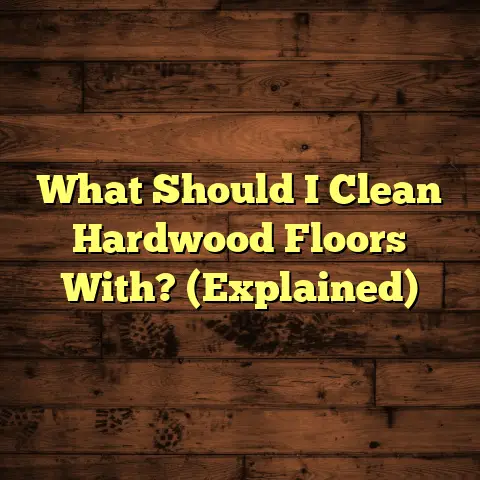Does LVP Flooring Expand? (10 Factors That Matter!)
Are you tired of worrying about whether your luxury vinyl plank (LVP) flooring will expand or contract, potentially ruining your beautiful floors?
I get it. As a flooring contractor for over 15 years, I’ve seen firsthand the headaches that expansion issues can cause.
That’s why I’m writing this article – to give you the lowdown on LVP expansion and how to avoid problems.
Let’s dive in!
Understanding LVP Flooring
LVP, or Luxury Vinyl Plank, is a type of flooring designed to mimic the look of hardwood or stone.
It’s made from several layers, including a waterproof vinyl core, a decorative printed layer, and a protective wear layer.
Think of it as a super-durable, water-resistant alternative to traditional flooring.
LVP has become incredibly popular for both homes and businesses.
Why? Well, it’s cost-effective, easy to install, and can withstand a lot of wear and tear.
Plus, it looks fantastic!
What is Flooring Expansion?
Expansion and contraction are natural phenomena that affect almost all building materials.
It’s basically the tendency of a material to change in volume in response to temperature changes.
When temperatures rise, materials expand; when they drop, materials contract.
Humidity also plays a big role. Materials like wood absorb moisture and swell, while dry conditions can cause them to shrink.
This movement can cause issues like buckling, gapping, or even cracking in your flooring if not properly accounted for.
That’s why understanding expansion is crucial when installing any type of flooring.
10 Key Factors That Influence LVP Flooring Expansion
Okay, let’s get to the meat of the issue. Here are 10 key factors that significantly influence LVP flooring expansion:
Factor 1: Material Composition
Higher quality LVP often contains more stable vinyl compounds and thicker wear layers, making it less prone to expansion.
Cheaper LVP, on the other hand, may use less stable materials that react more drastically to temperature changes.
I’ve seen this firsthand. For example, I once installed two different LVP brands in similar environments.
This is because the cheaper LVP had a higher filler content, making it less dimensionally stable.
Factor 2: Installation Method
How you install your LVP can make a huge difference.
There are generally two main methods: floating and glue-down.
Floating floors aren’t directly attached to the subfloor. Instead, the planks interlock and “float” above the subfloor.
Glue-down floors, as the name suggests, are glued directly to the subfloor.
I typically recommend a floating installation for most residential projects, especially in areas with fluctuating temperatures or humidity.
It allows the floor to expand and contract without putting pressure on the walls, which can cause buckling.
Factor 3: Environmental Conditions
Extreme temperature fluctuations can cause LVP to expand and contract more than normal.
High humidity can cause the planks to swell, while low humidity can cause them to shrink.
According to the Vinyl Flooring Institute, maintaining a consistent temperature between 65°F and 85°F and a relative humidity between 30% and 50% is ideal for LVP flooring.
I always advise my clients to invest in a good thermostat and, if necessary, a humidifier or dehumidifier to maintain these conditions.
Factor 4: Acclimation Period
Acclimation is the process of allowing the LVP to adjust to the environment where it will be installed before you actually install it.
This is crucial!
Think of it like this: you wouldn’t run a marathon without warming up, right?
The same goes for LVP.
By allowing the LVP to acclimate, you’re giving it time to expand or contract to its “normal” size in that environment.
I recommend acclimating LVP for at least 48 to 72 hours before installation.
The manufacturer’s instructions will usually specify the exact acclimation period.
Factor 5: Subfloor Type
Common subfloor types include concrete, plywood, and OSB (oriented strand board).
Concrete subfloors can be particularly problematic if they’re not properly sealed or if they have moisture issues.
Moisture from the concrete can seep into the LVP, causing it to swell and expand.
Wood subfloors, like plywood or OSB, can also be affected by moisture.
However, they tend to be more forgiving than concrete.
I always recommend testing the moisture content of the subfloor before installing LVP.
A moisture meter is your best friend here.
If the moisture content is too high, you’ll need to address the issue before proceeding with the installation.
Factor 6: Underlayment Choices
Underlayment is a thin layer of material that goes between the subfloor and the LVP.
It provides cushioning, sound insulation, and, most importantly, helps to mitigate expansion and contraction.
Some LVP products come with attached underlayment, while others require a separate underlayment.
When choosing an underlayment, look for one that’s specifically designed for LVP and that has good moisture resistance.
I’ve found that underlayments with a closed-cell foam construction are particularly effective at preventing moisture from reaching the LVP.
Factor 7: Plank Size and Thickness
Larger planks tend to expand and contract more than smaller planks because they have a greater surface area.
Thicker planks are generally more stable than thinner planks and less prone to expansion issues.
I typically recommend using thicker planks, especially in areas with high traffic or temperature fluctuations.
While they may cost a bit more upfront, they’ll save you headaches in the long run.
Factor 8: Climate Control Systems
HVAC (heating, ventilation, and air conditioning) systems play a crucial role in maintaining stable conditions for LVP flooring.
By regulating temperature and humidity, HVAC systems can minimize the amount of expansion and contraction that the flooring experiences.
I always encourage my clients to invest in a good HVAC system and to use it consistently.
Programmable thermostats are a great way to maintain a consistent temperature even when you’re not home.
Factor 9: Moisture Control
Moisture is the enemy of LVP flooring.
Excessive moisture can cause the planks to swell, warp, and even develop mold or mildew.
That’s why it’s crucial to implement proper moisture control measures.
This includes using moisture barriers, such as polyethylene film, beneath the LVP, especially over concrete subfloors.
It also means addressing any existing moisture problems in the subfloor before installation.
I’ve seen countless flooring projects ruined by neglecting moisture control.
Don’t make the same mistake!
Factor 10: Maintenance and Care
Proper maintenance and care can significantly influence the longevity and stability of LVP flooring.
Regular cleaning helps to remove dirt and debris that can scratch or damage the wear layer.
Avoiding excessive moisture, such as spills or standing water, can prevent swelling and warping.
I recommend using a damp mop with a neutral pH cleaner specifically designed for LVP flooring.
Avoid using harsh chemicals or abrasive cleaners, as these can damage the finish.
Simple routine maintenance helps to keep your LVP looking its best for years to come.
Conclusion
So, does LVP flooring expand? The answer is yes, but the extent to which it expands depends on a variety of factors.
Understanding these factors – material composition, installation method, environmental conditions, acclimation period, subfloor type, underlayment choices, plank size and thickness, climate control systems, moisture control, and maintenance and care – is crucial for preventing issues related to LVP flooring expansion.
By being informed about these aspects, you can make better flooring choices, implement proper installation techniques, and adopt effective maintenance practices.
This will ensure that your LVP flooring looks beautiful and performs well for years to come.
Remember, a little bit of knowledge goes a long way in the world of flooring!





